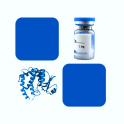
- Remove this product from my favorite's list.
- Add this product to my list of favorites.
Products
Viewed products
Newsletter
 |  |  |  |  |  |

Background
CD40 ligand is also known as CD40L, CD154, TNFSF5 and T-cell antigen Gp39, is a single-pass type I I membrane protein which belongs to the TNF superfamily of molecules. CD40 ligand is expressed predominantly on activated CD4+ T lymphocytes, and also found in other types of cells, including platelets, mast cells, macrophages, basophils, NK cells, B lymphocytes, as well as non-haematopoietic cells (smooth muscle cells, endothelial cells, and epithelial cells). Although all monomeric, dimeric and trimeric forms of soluble CD40 ligand can bind to CD40, the trimeric form of soluble CD40 ligand has the most potent biological activity through oligomerization of cell surface CD40, a common feature of TNF receptor family members. CD40 ligand binds to CD40 on antigen-presenting cells (APC), which leads to many effects depending on the target cell type. In general, CD40 ligand plays the role of a costimulatory molecule and induces activation in APC in association with T cell receptor stimulation by MHC molecules on the APC. In total CD40 ligand has three binding partners: CD40, α5β1 integrin and αIIbβ3. CD40 ligand regulates B cell function by engaging CD40 on the B cell surface. A defect in this gene results in an inability to undergo immunoglobulin class switch and is associated with hyper IgM syndrome.
Source
Recombinant Human CD40 Ligand, His,Flag Tag, premium grade (CDL-H52Db) is expressed from human 293 cells (HEK293). It contains AA Gly 116 - Leu 261 (Accession # P29965-1) trimer Design.
Predicted N-terminus: His
It is produced under our rigorous quality control system that incorporates a comprehensive set of tests including sterility and endotoxin tests. Product performance is carefully validated and tested for compatibility for cell culture use or any other applications in the early preclinical stage. When ready to transition into later clinical phases, we also offer a custom GMP protein service that tailors to your needs. We will work with you to customize and develop a GMP-grade product in accordance with your requests that also meets the requirements for raw and ancillary materials use in cell manufacturing of cell-based therapies.
Molecular Characterization
This protein carries a polyhistidine tag at the N-terminus, followed by a flag tag.
The protein has a calculated MW of 49.9 kDa. The protein migrates as 45-55 kDa when calibrated against Star Ribbon Pre-stained Protein Marker under non-reducing (NR) condition (SDS-PAGE) due to glycosylation.
Endotoxin
Less than 0.1 EU per μg by the LAL method.
Sterility
The sterility testing was performed by membrane filtration method.
Mycoplasma
Negative.
Purity
>90% as determined by SDS-PAGE.
>95% as determined by SEC-MALS.
Formulation
Lyophilized from 0.22 μm filtered solution in PBS, pH7.4 with trehalose as protectant.
Reconstitution
Please see Certificate of Analysis for specific instructions.
For best performance, we strongly recommend you to follow the reconstitution protocol provided in the CoA.
Storage
For long term storage, the product should be stored at lyophilized state at -20°C or lower.
Please avoid repeated freeze-thaw cycles.
This product is stable after storage at:
-20°C to -70°C for 12 months in lyophilized state;
-70°C for 3 months under sterile conditions after reconstitution.
Bioactivity
Please refer to product data sheet.
(1) Co-stimulators CD40-CD40L, a potential immune-therapy target for atherosclerosis: A review"
Tian, Wang, Wan et al
Medicine (Baltimore) (2024) 103 (14), e37718
(2) "Bilateral Slipped Capital Femoral Epiphysis in a Young Girl Treated With Chemotherapy: A Case Report"
van Erp, Kuperus, Bekkers et al
JBJS Case Connect (2024) 14 (2)
(3) "Bariatric Surgery Improves Serum CD40L Levels as a Predictor of Cardiovascular Risk: Systematic Review and Meta-analysis"
Jamialahamdi, Eid, Nguyen et al
Obes Surg (2024)
Showing 1-3 of 8356 papers.
Recombinant human CD40 / TNFRSF5 Protein, Fc Tag (HPLC-verified), 100µg - 409,50 €
Recombinant Human CD40 /TNFRSF5 Protein, His Tag, 200µg - 500,50 €
Recombinant Biotinylated Human CD40 / TNFRSF5, Avi Tag (Avitag™), His tag, 25µg - 487,50 €
Recombinant Biotinylated Human CD40 / TNFRSF5 Protein, Fc, Avitag™, 25 µg - 468,00 €
Follow us